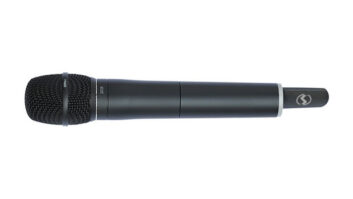
Wireless components specifically for gathering live event broadcast audio include a broad range of options in transmitters and receivers, communication (comm) and interruptible foldback (IFB) systems, the transducers themselves, and many accessories and tools. Mix called on James Stoffo of Radio Active Designs (RAD) to shine a bit of light on this increasingly complex subject, complete with its frequency- and logistical-based challenges.
“I’ve seen the whole RF industry go from VHF to UHF and now back to VHF—the auctions in all these large events, the RF congestion in the UHF bands,” he says. “We created RAD because if we didn’t, there would be a good chance I’d be in a different business altogether, as I only do wireless. We’ve lost 35 percent of the UHF spectrum already and we’re about to lose another 35 percent or more. Somebody had to do something, so that’s where RAD came from.”
Because of the recent loss of 700MHz RF spectrum through auction and a potential loss of at least 128 MHz in the 600MHz band, other frequencies such as 900 MHz and 2.4 GHz have become popular, just to avoid the UHF congestion.
“We have no choice,” Stoffo says. “We have to vacate the UHF spectrum. No question about it. For example, with 900 MHz and frequencies over a gig, a lot of manufacturers are looking there for wireless microphone [product development] because it’s appropriate. For comms, we did the opposite—we went down in frequency. That’s because, for comm, VHF is appropriate.”
In the future, this migration from the traditional UHF spectrum—470 to 698 MHz—will continue in wireless and comm systems, Stoffo says. “With wireless microphones, comms and IFB—but not in-ears, yet—I would expect to see more products introduced in 900 MHz, down in VHF. We did it at Radio Active Designs, and Lectrosonics and Shure have followed, and are now selling equipment in VHF spectrum. Shure ULX-D Series was introduced at NAMM and Lectrosonics makes an IFB down there. Clearly it legitimizes the moves outside of the traditional audio spectrum. I expect you’ll also see a lot of gear coming from manufacturers above the spectrum—900 MHz, 902 to 928 MHz, 944 to 952, and above one gig, 1.9 GHz and 2.4 GHz, and possibly 1.4 GHz. It just has to be coordinated with aeronautical organizations. It depends on how fast the auctions take place, but certainly within the next one to three years, you’ll see a migration out of UHF and into other spectrums, and you’ll see UHF ears.”
And now, Mix presents some available systems from nine key wireless manufacturers for use in broadcast.
AKG
AKG’s DMS800 reference digital wireless microphone system features two digital audio outputs for DANTE and AES/EBU, along with the DHT800 handheld transmitter, interchangeable microphone heads, DSR800 stationary receiver and the DPT800 wireless body pack transmitter. The system offers two balanced XLR and two unbalanced jack connectors, as well as digital wireless audio transmission with low-cut filter, 3-band equalizer, dbx compressor and dbx limiter. The DMS800 allows users to choose from a variety of premium dynamic and condenser vocal microphones, including the D5 WL1, D7 WL1 and C5 WL1. Up to 40 channels are available with the DMS800, which can be used simultaneously. The DMS800 offers an up to 150MHzultra-wide frequency range. Also, 512-bit encryption ensures state-of-the-art protection for sensitive audio information.

Audio-Technica
Audio-Technica offers a broad range of wireless microphone systems in UHF, VHF, 2.4 GHz and Ultra Wideband (UWB); UHF wireless in-ear monitoring systems; dozens of high-quality subminiature condensers, plus head-worn, shotgun and boundary microphones for wireless use; and various UHF and RF antenna and booster accessories.
Audio-Technica’s System 10 2.4 GHz wireless range has become popular of late. I recently reviewed a System 10 PRO product, the 24-bit/48kHz ATW-1312 dual-channel bodypack/handheld package comprising a half-rack chassis with two receiver unit slots. Via Ethernet, each rig’s receivers can also be mounted remotely, up to 300 feet away from the chassis—a considerable savings in applications where normally an antenna distributor would be employed. Five System 10 PRO chassis can be linked via RJ12 cabling for a total of 10 channels per system.

Clear-Com
Clear-Com, reportedly the first manufacturer to market portable wired and wireless intercom systems for live performances, has been in business since 1968. Its latest, the DX410, is a 2-channel 2.4 GHz digital wireless intercom system featuring 7kHz wideband audio for next-level audio clarity. It also features lightweight beltpacks and all-in-one wireless headsets. Each BS410 base station can support up to 15 registered BP410 wireless beltpacks and/or WH410 All-in-One wireless headsets. In a single-channel operation, any four beltpack users can engage in simultaneous, full-duplex (talk-listen) communication, while three users may be in full-duplex mode in a dual-channel operation.

Lectrosonics
Wireless and IFB products are at the core of Lectrosonics’ business in broadcast wireless audio systems. Transmitters include hearty handhelds (like the HH) to tiny micro beltpacks (like the SSM), which offers a total of 3,072 available frequencies across three standard frequency blocks. Digital Hybrid Wireless Compact and Venue UHF receiver packages are available, too. A range of VHF and IFB products, a Digital Wireless transmitter and receiver, as well as a variety of pre-packaged systems and accessories round out Lectrosonics’ wireless range.

Pliant Technologies
Pliant’s digital wireless systems—the Tempest2400 and Tempest900—operate in a license-free 2,400 to 2,480MHz frequency band, while the Tempest900 is in the 902 to 928MHz frequency band; they are each available in either 2-channel or 4-channel versions. Tempest 2400 systems have the ability to operate up to 11 BaseStations and 55 full-duplex BeltStations in the same RF space, at the same time, with no license requirements and no frequency coordination. The Tempest900 system can have a maximum of five BaseStations and 25 full-duplex users.

Sennheiser
Sennheiser provides many professional wireless products, a good amount of which are specifically built for broadcast audio use. These include lavalier, headset and camera-mount microphones; 2000, 3000 and 5000 Series UHF Transmitter/Receiver products; Digital 9000 for broadcast studio apps; specialized shotgun, various broadcast-friendly and MKH Series RF condenser microphones; and much more.
Sennheiser isn’t ignoring the “over a Gig” frequency landscape, either. I recently reviewed Sennheiser’s relatively new AVX Handheld Mic Set, an affordable 1.9 GHz-band handheld digital wireless kit for indoor or outdoor HD video sound. I found the AVX-835 package to be a very useful tool in a far wider range of applications—anywhere a great-sounding wireless handheld transducer and accompanying tiny receiver hardware is desirable (and a latency of 19 milliseconds won’t really matter). This entire road-ready kit fits inside its compact padded Sennheiser wireless mic zipper pouch. Best of all, both the transmitter (AVX SKM) and receiver (AVX EKP) hold lithium-ion batteries, rechargeable via mini USB (B-type) connection, making this a truly modern on-the-go handheld wireless system for a variety of purposes.

Shure
Providing a broad range of subminiature condensers plus head-worn, shotgun and boundary microphones for wireless use, Shure is a rich source of both wireless personal monitoring systems and microphone transmitter and receiver packages available from BLX, GLX-D, PGX-D, FB, SLX, ULX-S, QLX-D, ULX-D, UHF-R, as well as flagship Axient UHF Series categories.
In particular, Shure’s long-running QLX-D Digital Wireless System (with lithium-ion rechargeable power options to provide up to 10 hours of continuous use) provides 24-bit digital audio, networked control and compatibility with the company’s intelligent rechargeable battery technology. The system features automatic channel scan and IR sync, and is intended for live sound events and/or installations at corporate and government facilities, academic institutions, houses of worship, hotels, music venues, and other venues.

Sony
Sony offers high-quality shotgun microphones and a range of lavalier/worn models, plus its digital UHF DWX, 2.4 GHz digital DWZ, and UHF UWP Wireless Series of transmitters, receivers and various accessories. TV composer Rich Tozzoli (NBC Olympics, Duck Dynasty) has experienced the benefits of the DWZ Series via its digital guitar wireless system, the DWZ-G30GB.
Tozzoli explains: “Overall, the Sony DWZ-B30GB is a tight, affordable little package. More importantly, it sounds great, is solid and compact, has respectable battery life and can be used effectively both onstage and in the studio. Its narrow mode, which does not hop across the 2.4 GHz band, is intended for need-specific frequency coordination, taking into account other wireless applications in that particular spectrum. The audio signal coming out of the receiver is 24-bit linear PCM with no compression, so it’s crystal clear.”

Wisycom
Designer and builder of sophisticated RF solutions for broadcast, film and live production, Wisycom, based in Italy, offers MPR30ENG, a compact true diversity receiver designed for professional ENG, broadcast, and field production applications. MPR30ENG features two whip antennas along with wide-band tuning in the 470/ 952MHz range up to 230 MHz. All audio processing is managed by DSP to allow multi-companding, audio enhancement and digital control data. It has an OLED display, dedicated function buttons, automatic transmitter programming through infrared and USB, and mic and line balanced inputs.

Zaxcom
Zaxcom offers robust digital transmitters and transceivers via its UHF TRX Series, UHF receivers via QRX or RX Series, and even unique offerings such as its ZFR miniature field recorders.
Strother Bullins is Technology Editor for NewBay Media’s AV/Pro Audio Group.







